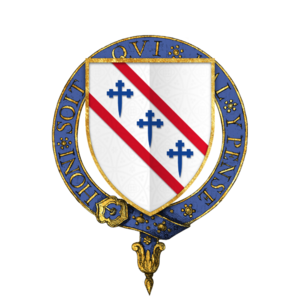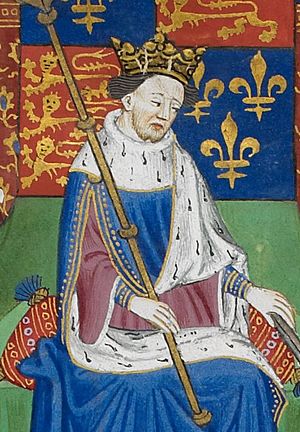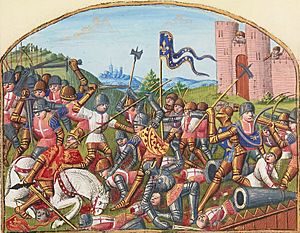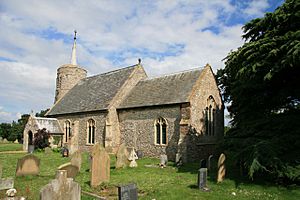Edward Hull (knight) facts for kids
Sir Edward Hull (born around 1410 – died 17 July 1453) was an English knight. He was a military leader during the Hundred Years' War. His family supported the Lancaster kings. Edward Hull became a close friend of King Henry VI and his wife, Margaret of Anjou. He fought in France and worked as an ambassador to other countries. Hull held many important jobs, including being a royal attendant and a sheriff in England.
Hull was put in charge of Bordeaux in Southern France in 1442. This job earned him a lot of money from taxes on wine exports. Bordeaux was captured by the French in May 1451. Hull then joined a group trying to get the city back. He went with an army led by John Talbot, 1st Earl of Shrewsbury in summer 1452. They successfully took Bordeaux back in October. Hull became a knight of the Order of the Garter in May 1453. Later that year, he joined Talbot to help a city called Castillon that was under attack. Hull was killed in the battle there. In the late 1440s, he had a disagreement with Sir John Fastolf over who owned land in Titchwell in Norfolk. After Hull's death, the land went back to Fastolf.
Contents
Early Life and Royal Service
Edward Hull was born around 1410. His father, John Hull, worked for King Henry IV. His mother, Eleanor, worked for Henry IV's wife, Joan of Navarre, Queen of England. Hull's family strongly supported the House of Lancaster.
Serving the King
Hull went with Henry VI of England to France from 1430 to 1432. During this trip, Henry was crowned the King of France in Paris. By 1431, Hull was known as a close helper of Queen Joan. Hull fought for the king in Normandy during the 1430s as part of the Hundred Years' War. He received many royal jobs and payments.
In July 1438, he became a royal attendant to Henry VI. He received money each year from the manor of Gillingham, Dorset. Later that year, he was given half ownership of a ship that the king had taken. Also in 1438, he became the sheriff of Somerset and Dorset for the first time. Hull was also made a justice of the peace for Somerset in March 1440.
Diplomat and Constable
Hull was sent to the king's area of Aquitaine in France in 1440. He returned to England by April 1441. He was then given temporary control of Kenn and Kingston Seymour in Somerset. This happened because their owner was too young to manage them. In October 1441, he went on a diplomatic trip to Germany.
Hull was appointed Constable of Bordeaux on 17 September 1442. This job gave him a lot of money from taxes on wine exports. Hull was also one of the ambassadors sent by Henry VI to John IV, Count of Armagnac in October 1442. They carried the king's offer to marry one of John's daughters.
Close to the Queen
Hull became sheriff of Somerset and Dorset again in 1443. From that year, he also worked on royal projects in that county. Hull was appointed a trustee for the Duchy of Lancaster in November 1443. This showed he was very close to the royal court. By Christmas, he had also become a knight of the queen's household.
He was part of the group that escorted Margaret of Anjou to England in 1444-1445 for her marriage to Henry VI. Hull was made a knight during that trip, at Christmas 1444. He was a special attendant to Margaret at her coronation in May 1445. Hull became good friends with Queen Margaret. By November 1448, he was appointed her carver, receiving money each year.
Hull stayed mostly in England between 1447 and 1450. He left Bordeaux to be managed by someone else. In 1447, he was chosen to be a member of the House of Commons for Somerset. This was likely because of his royal connections. In May that year, Hull and his wife were given the right to hunt freely in Milton, Somerset. In 1448, he received two more ships that the king had taken. Hull was again sheriff of Somerset and Dorset for 1448–1449. He became sheriff of Glamorgan in July 1449. In October, he was given money each year from customs duties in Bristol.
His close friendship with Henry VI meant he was not affected by a law in 1450. This law tried to get back lands the king had given away. In June 1451, Hull and his mother gave their right to money from the abbot and convent of St Albans to Eton College. This money had been given to them by the king. He was sheriff of Devon for 1451–52.
The Battle of Castillon
In May 1451, a French army defeated an English force in Normandy. The French then moved south and captured Blaye, Bourg, and Bordeaux by June 12. This ended Hull's time as constable of Bordeaux. Hull went to defend Jersey. The king kept him as part of a group to get back the lost areas.
Hull sailed to Aquitaine in summer 1452 with an army led by John Talbot, 1st Earl of Shrewsbury. The French king, Charles VII, heard about the English army. He moved his forces to Normandy, expecting an attack there. So, Shrewsbury and Hull were able to capture Bordeaux in October 1452. Early the next year, Hull was again made constable of the city. Hull was made a member of the Order of the Garter in May 1453, even though he wasn't there. He had been a squire in the order before. His military career likely helped him get this honor.
Talbot then moved to help the French city of Castillon, which was under attack. Hull joined Talbot with 2,000 of his own men. Hull was one of only two English members of parliament with the army. This might show that many nobles were tired of the war. The other member of parliament was John Howard.
The battle happened on 17 July 1453. The English army started well. But an English attack against the main French line suffered heavy losses from cannon fire. Hull was killed, along with Talbot and his son John Talbot, 1st Viscount Lisle. The town fell to the French two days later. The French then moved on Bordeaux, which was taken on 19 October. This ended the war. Hull had no children, and his death ended his family line. Some old records say Hull was captured at Bordeaux and not killed at Castillon. They also say he died on 3 September 1454. Because he died, Hull was never officially made a Knight of the Garter.
The Titchwell Land Dispute
Hull was involved in a disagreement over land with another knight, Sir John Fastolf. The land was the manor of Titchwell in Norfolk. Fastolf had bought it around 1431. Hull argued that the person who sold it to Fastolf did not have the right to do so. Hull really wanted to own Titchwell because he didn't own any land before this.
Hull claimed that his wife, Margery Lovel, had a right to the land. She had married Hull before 1441. Her claim was shared with her sister Agnes, who was married to Thomas Wake. Hull's case was based on the idea that his wife's grandfather was a brother of Ralph Lovel of Titchwell.
A royal investigation was held on 30 October 1448. It found that the seller had no right to the land. It said the land should have gone back to the king when the seller's wife died. So, the king took the land. Based on Hull's claim, the investigation gave Hull the right to rent a farm on the land. He paid a very low rent for it.
Hull planned more legal actions to get full ownership of the manor for his wife and sister-in-law. Fastolf challenged the investigation's findings in court starting in January 1449. Fastolf paid people to investigate. They found that it was unlikely Margery and Agnes were related to the Lovels of Titchwell, but they couldn't prove it. Fastolf's lawsuit then failed. By mid-1451, he had given up on getting the manor back.
Hull's death in 1453 allowed Fastolf to start the legal process again. With Hull dead, Wake had little power. A court jury in mid-1455 decided completely in Fastolf's favor. He was given ownership of the manor on 1 April 1456.





